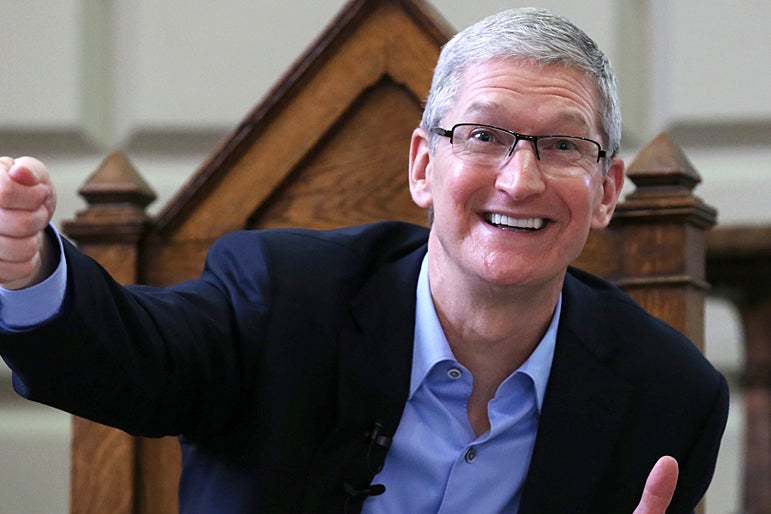Unveiling Apple’s Strategy: The High Stakes Behind Trump’s Tariff Policies
As the economic landscape shifts under the weight of changing trade policies, Apple Inc. finds itself navigating a complex maze of challenges and opportunities. The looming specter of Trump’s tariff policies adds an element of uncertainty, compelling the tech giant to strategize effectively. In this article, we delve into how these tariffs could impact Apple and its crucial supplier, Taiwan Semiconductor Manufacturing Company (TSMC), while examining broader implications for the global tech industry.
Understanding Trump’s Tariff Policies
Trump’s tariff policies, particularly during his presidency, aimed to protect American industries by imposing taxes on imported goods, primarily from countries like China. This approach was designed to encourage domestic production but had significant global repercussions. For companies reliant on international supply chains, like Apple, these tariffs could mean higher costs for components and ultimately, products.
With the current political climate, there’s a looming possibility of reinstated or new tariffs as the U.S. government seeks to leverage trade policies for political stability. Companies like Apple, which depend heavily on manufacturing in Asia, need to be agile in their responses to these changes.
Apple’s Manufacturing Landscape
Apple’s strategy has long been to leverage the global supply chain to keep costs down while maintaining quality. The company’s major production partner, TSMC, plays a pivotal role in manufacturing chips for Apple devices. With the geopolitical tensions and the threat of tariffs, Apple must consider various strategies to mitigate potential losses:
- Shifting Production Locations: Apple has been exploring options to diversify its manufacturing footprint beyond China. This includes increasing production in countries like India and Vietnam, which could help buffer against tariffs.
- Vertical Integration: Investing directly in production capabilities or forming closer partnerships with suppliers like TSMC could enable Apple to exert more control over its supply chain, potentially reducing vulnerability to tariffs.
- Price Adjustments: Apple might consider adjusting prices to offset increased costs from tariffs. However, this strategy risks alienating consumers, especially in a competitive market.
The Role of Taiwan Semiconductor Manufacturing Company
TSMC is not just a supplier; it’s the world’s largest semiconductor manufacturer. The relationship between Apple and TSMC is crucial for the production of cutting-edge chips used in iPhones, iPads, and Macs. With the potential for tariffs affecting components imported from Asia, TSMC’s operations could face scrutiny as well. Here are some considerations:
- Supply Chain Resilience: TSMC has invested in building a robust supply chain that can withstand disruptions. However, tariffs could complicate logistics, increasing costs and lead times.
- Innovation and R&D: TSMC’s commitment to research and development is paramount. Continued investment in advanced technologies helps maintain its edge, which is vital for Apple’s competitive positioning.
- Strategic Partnerships: The collaboration between Apple and TSMC in developing new chips could benefit both parties. As Apple seeks to innovate, TSMC’s role becomes even more critical.
Potential Implications for Apple
As Apple maneuvers through the uncertainties of Trump’s tariff policies, several implications arise:
- Increased Costs: If tariffs are imposed on components sourced from TSMC, Apple may face increased production costs, which could impact profit margins.
- Market Competition: Competitors may also be affected by tariffs. Apple must remain vigilant, as any shifts in pricing or product availability could provide competitors with an opportunity to capture market share.
- Consumer Sentiment: Apple’s reputation for quality and value is paramount. Any price increases due to tariffs could lead to backlash from consumers, affecting sales.
Adapting Strategies in a Changing Environment
To navigate the high stakes of Trump’s tariff policies, Apple must stay proactive. Here are some strategies the company can implement:
- Enhanced Supply Chain Flexibility: Developing a more flexible supply chain that can quickly adapt to changes in tariffs or trade policies will be crucial. This could involve setting up alternative suppliers or localized manufacturing.
- Investment in U.S. Manufacturing: Increasing domestic production could not only help mitigate tariff impacts but also align with public sentiment favoring American manufacturing jobs.
- Consumer Education: Apple could engage in marketing strategies that educate consumers on the reasons behind potential price increases, emphasizing quality and innovation.
Looking Ahead: A Balancing Act
As Apple moves forward, the balancing act between maintaining competitive pricing and ensuring quality will be paramount. The interplay of tariffs, supply chain dynamics, and consumer expectations creates a multifaceted challenge. However, Apple’s history of innovation and strategic agility suggests that the company is well-equipped to handle these hurdles.
Ultimately, the impact of Trump’s tariff policies on Apple and TSMC will depend on a confluence of factors, including government decisions, market responses, and global economic conditions. By staying ahead of the curve and adapting to changes, Apple can continue to thrive in an ever-evolving tech landscape.
Conclusion
In conclusion, the stakes behind Trump’s tariff policies are high for Apple and its partners, particularly TSMC. As the company navigates this complex environment, its strategies will significantly influence its ability to maintain its market dominance. By understanding and addressing potential challenges, Apple can continue to innovate and deliver exceptional products to consumers worldwide.
See more Business Focus Insider Team

